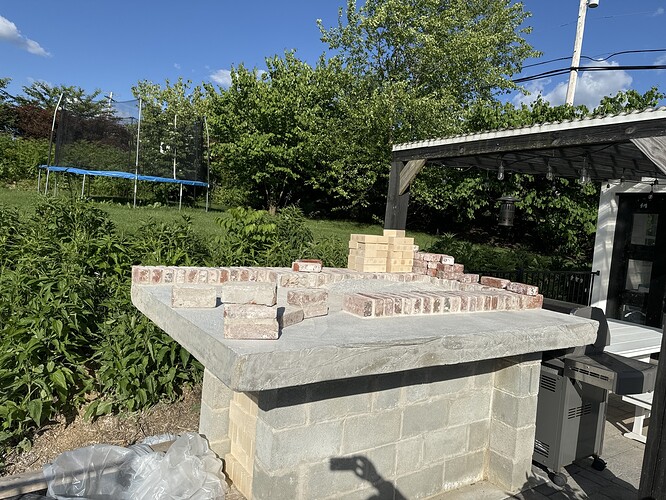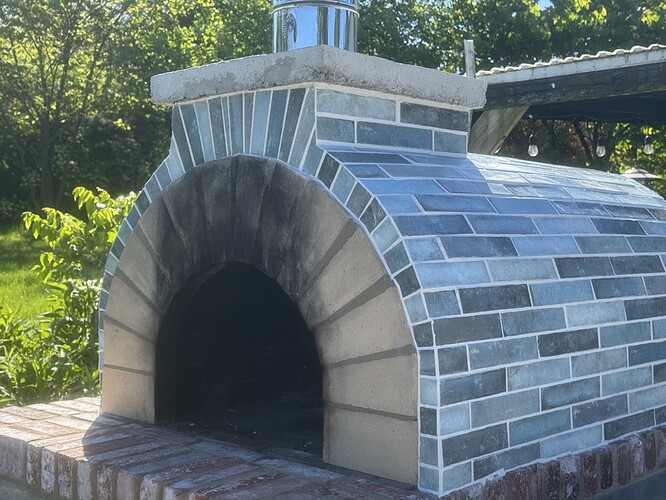So I’m working on the barile grand pizza oven and decided to switch the opening side. Since I overbuilt the slab (surrounding back and 1 side with bar height concrete counter) I needed to cut the concrete slab to add the vermiculite mix… is it ok to cut the slab recess, and what is the minimum depth for the vermiculite mix? - 1”?
Hi FFW and welcome to the BrickWood forum!
This is kinda a new one on me, I confess!
If you built your insulated slab per specs (other than the modifications for the counter) you should have a 2-inch deep layer for insulation.
You can cut it that deep, but not much deeper, because you have rebar under that. I recommend that you get as close to 2 inches deep as you can, to avoid the concrete slab becoming a heat sink. (While heat energy rises in air, conduction will transfer heat energy from hot to cold.)
You will also need enough additional firebrick in the “herringbone” pattern to make up the difference, as it sounds like you will be shifting the oven footprint from where it was originally planned.
If I’m not understanding your question fully, please let me know with some clarifying details. Thanks!
Thanks, I read a bunch of other threads… I didn’t realize it was for a heat break to retain heat in the oven… I will cut it deeper. Thx.
Got it! Thanks for the photo as well; they always help.
I’d really love if you could post photos along the way. We’re always interested when builders like you make modifications to the basic design. It does look like the “counter” you’re adding will be quite useful, and it would be great to see how that looks when finished.
Thanks and good luck with your build.
I’m now insulated and ready for the concrete layer… do I need to use chicken wire or is a traditional wire lath acceptable? Lath is the typical under stucco on walls.
Congrats on reaching this step!
Either chicken wire or traditional wire lath is fine. As long as you have a matrix on which your stucco can form a layer over the soft mineral fiber, you’re good to go.
As you no doubt know as you’ve followed along in the instructions, the materials are designed to be fairly easy to obtain for the no-experience, first-time builder—but the design is robust enough to outlast the lifetimes of most of us. Spec’ing chicken wire is an example of using a material that is both inexpensive and flexible, in a layer where the difference between chicken wire and metal lath really does not matter.
Got it thanks. Also, I plan to tile the exterior. Any tile types to stay away from? Glass/ ceramic/ porcelain?
Different builders have used the full range of hard materials for their oven veneers. My suggestion would be to browse the gallery and look at photos there.
Obviously you would want to be mindful of dimensions. Your veneer needs to wrap around a curved surface, and tiles don’t bend—they break. And you want to choose an adhesive method that’s compatible with the veneer you’re using. Thinset mortar works fine, and some have used construction adhesive.
But builders have used anything from river stones to subway tile for their exterior. This is your opportunity to let your creativity shine.
Beautifully done! May not seem perfect to you but to all the “beholders” out here I’m sure it looks great.
Thank you so much for posting this photo, and may there be many fire-baked pizzas in your future.
Looks fantastic! The tile looks amazing, it looks so well done that I would have guessed they were some type of blue bricks. Congratulations! Please share some pizza photos and enjoy your pizza journey!
Thanks, Will definitely send some more pics, daughters and their friends are already planning pizza parties!

